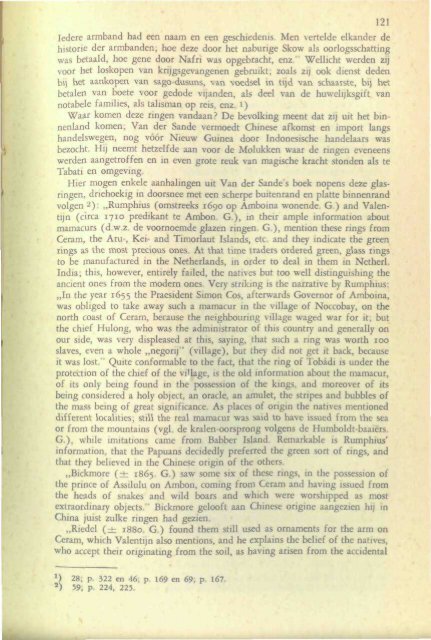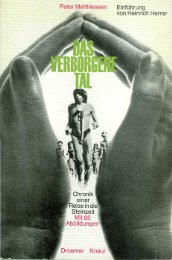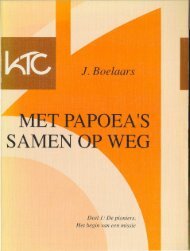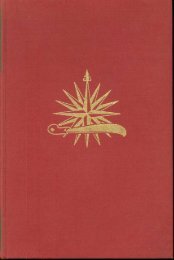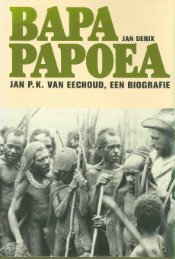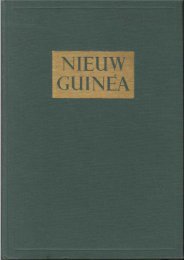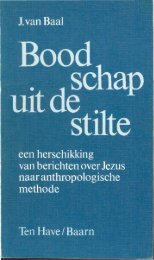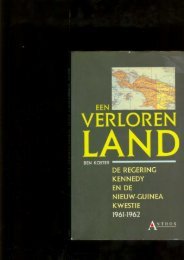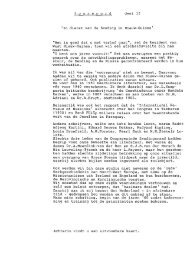Untitled - Stichting Papua Erfgoed
Untitled - Stichting Papua Erfgoed
Untitled - Stichting Papua Erfgoed
Create successful ePaper yourself
Turn your PDF publications into a flip-book with our unique Google optimized e-Paper software.
121<br />
Iedere armband had een naam en een geschiedenis Men vertelde elkander de<br />
historie der armbanden, hoe deze door het naburige Skow als oorlogsschatting<br />
was betaald, hoe gene door Nafri was opgebracht, enz Wellicht werden ZIJ<br />
voor het loskopen van krijgsgevangenen gebruikt, zoals zij ook dienst deden<br />
bij het aankopen van sago-dusuns, van voedsel in tijd van schaarste, bij het<br />
betalen van boete voor gedode vijanden, als deel van de huwelijksgift van<br />
notabele families, als talisman op reis, enz. 1 )<br />
Waar komen deze ringen vandaan? De bevolking meent dat zij uit het binnenland<br />
komen, Van der Sande vermoedt Chinese afkomst en import langs<br />
handelswegen, nog voor Nieuw Guinea door Indonesische handelaars was<br />
bezocht. Hij neemt hetzelfde aan voor de Molukken waar de ringen eveneens<br />
werden aangetroffen en in even grote reuk van magische kracht stonden als te<br />
Tabati en omgeving.<br />
Hier mogen enkele aanhalingen uit Van der Sande's boek nopens deze glasnngen,<br />
driehoekig in doorsnee met een scherpe buitenrand en platte binnenrand<br />
volgen 2 ): ,,Rumphius (omstreeks 1690 op Amboina wonende G ) and Valentijn<br />
(circa 1710 predikant te Ambon. G. ), in their ample information about<br />
maraacurs (d.w.z. de voornoemde glazen ringen. G. ), mention these rings from<br />
Ceram, the Am-, Kei- and Timorlaut Islands, etc and they indicate the green<br />
rings as the most precious ones At that time traders ordered green, glass rings<br />
to be manufactured in the Netherlands, in order to deal in them in Netherl.<br />
India, this, however, entirely failed, the natives but too well distinguishing the<br />
ancient ones from the modern ones. Very striking is the narrative by Rumphius<br />
„In the year 1655 the Praesident Simon Cos, afterwards Governor of Amboina,<br />
was obliged to take away such a mamacur in the village of Noccobay, on the<br />
north coast of Ceram, because the neighbouring village waged war for it, but<br />
the chief Hulong, who was the administrator of this country and generally on<br />
our side, was very displeased at this, saying, that such a ring was worth 100<br />
slaves, even a whole „negorij " (village), but they did not get it back, because<br />
it was lost Quite conformable to the fact, that the ring of lobadi is under the<br />
protection of the chief of the village, is the old information about the mamacur,<br />
of its only being found in the possession of the kings, and moreover of its<br />
being considered a holy object, an oracle, an amulet, the stripes and bubbles of<br />
the mass being of great significance. As places of origin the natives mentioned<br />
different localities, still the real mamacur was said to have issued from the sea<br />
or from the mountains (vgl. de kralen oorsprong volgens de Humboldt baaiers<br />
G.). while imitations came from Babber Island Remarkable is Rumphius'<br />
information, that the <strong>Papua</strong>ns decidedly preferred the green sort of rings, and<br />
that they believed in the Chinese origin of the others.<br />
„Bickmore (± 1865. G. ) saw some six of these rings, in the possession of<br />
the prince of Assilulu on Ambon, coming from Ceram and having issued from<br />
the heads of snakes and wild boars and which were worshipped as most<br />
extraordinary objects Bickmore gelooft aan Chinese origine aangezien hij in<br />
China juist zulke ringen had gezien.<br />
„Riedel (± 1880. G. ) found them still used as ornaments for the arm on<br />
Ceram, which Valentijn also mentions, and he explains the belief of the natives,<br />
who accept their originating from the soil, as having arisen from the accidental<br />
1 ) 28; p. 322 en 46; p. 169 en 69; p. 167.<br />
2 ) 59; p. 224, 225.


